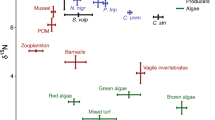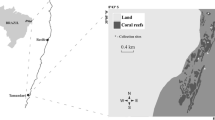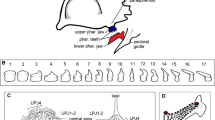Abstract
Despite the increasing need to understand factors shaping community assembly, few studies have simultaneously explored the influence of niche-based and phylogenetic processes. Here, we investigate the relationships between diet, habitat and social behaviour in damselfishes (Pomacentridae) collected in 2014 at Moorea Island (17°30′S, 149°50′W), French Polynesia. Isotope ratios of carbon and nitrogen, in association with stomach contents, delineate three trophic groups: pelagic feeders consuming zooplankton, benthic feeders mainly grazing on algae and an intermediate group feeding on prey from the whole bentho-pelagic compartment. Sulphur isotope ratios indicate segregation between species of the outer reef mostly depending on oceanic input of zooplankton and the lagoonal species relying on locally produced resources or even on terrestrial supply. We demonstrate a tight association between dietary specializations, habitat characteristics and social behaviours, and these correlations are further confirmed by integrating the phylogeny of Pomacentridae. We also provide evidence of phylogenetic conservatism for the stomach content and the habitat–behaviour characters. However, the isotopic trait is evolutionarily more labile probably because it thoroughly depicts the ecological niche of species. To summarize, pelagic feeders (mainly from the Chrominae) usually form shoals in areas close to the open ocean at a maximum depth of 20 m. Benthic feeders (well represented in the Stegastinae) are ubiquitous, solitary and mostly territorial species found at various depths. The intermediate group includes gregarious species from three subfamilies that forage in the lagoon usually above 12 m depth. Overall, we give insight into processes that have structured the damselfish community in Moorea.





Similar content being viewed by others
References
Adams DC (2014a) A generalized K statistic for estimating phylogenetic signal from shape and other high-dimensional multivariate data. Syst Biol 63:685–697. doi:10.1093/sysbio/syu030
Adams DC (2014b) A method for assessing phylogenetic least squares models for shape and other high-dimensional data. Evolution 68:2675–2688. doi:10.1111/evo.12463
Adams DC, Otárola-Castillo E (2013) geomorph: an R package for the collection and analysis of geometric morphometric shape data. Methods Ecol Evol 4:393–399. doi:10.1111/2041-210X.12035
Alfaro ME, Santini F, Brock CD (2007) Do reefs drive diversification in marine teleosts? Evidence from the pufferfish and their allies (Order Tetraodontiformes). Evolution 61:2104–2126. doi:10.1111/j.1558-5646.2007.00182.x
Allen GR (1991) Damselfishes of the world. Mergus, Germany
Blomberg SP, Garland T, Ives AR (2003) Testing for phylogenetic signal in comparative data: behavioral traits are more labile. Evolution 57:717–745. doi:10.1111/j.0014-3820.2003.tb00285.x
Cailliez F (1983) The analytical solution of the additive constant problem. Psychometrika 48:305–308. doi:10.1007/BF02294026
Cavender-Bares J, Kozak KH, Fine PVA, Kembel SW (2009) The merging of community ecology and phylogenetic biology. Ecol Lett 12:693–715. doi:10.1111/j.1461-0248.2009.01314.x
Ceccarelli DM, Jones GP, McCook LJ (2005) Foragers versus farmers: contrasting effects of two behavioural groups of herbivores on coral reefs. Oecologia 145:445–453. doi:10.1007/s00442-005-0144-y
Clarke KR (1993) Non-parametric multivariate analyses of changes in community structure. Aust Ecol 18:117–143. doi:10.1111/j.1442-9993.1993.tb00438.x
Collyer ML, Sekora DJ, Adams DC (2015) A method for analysis of phenotypic change for phenotypes described by high-dimensional data. Heredity 115:357–365. doi:10.1038/hdy.2014.75
Colwell RK, Fuentes ER (1975) Experimental studies of the niche. Annu Rev Ecol Syst 6:281–310. doi:10.1146/annurev.es.06.110175.001433
Connolly RM, Guest MA, Melville AJ, Oakes JM (2004) Sulfur stable isotopes separate producers in marine food-web analysis. Oecologia 138:161–167. doi:10.1007/s00442-003-1415-0
Cooper WJ, Santini F (2016) A revised damselfish taxonomy with a description of the tribe Microspathodontini (Giant damselfishes). In: Frédérich B, Parmentier E (eds) Biology of damselfishes. CRC Press, Boca Raton, pp 13–30
Cooper WJ, Westneat MW (2009) Form and function of damselfish skulls: rapid and repeated evolution into a limited number of trophic niches. BMC Evol Biol 9:24
Cooper WJ, Smith LL, Westneat MW (2009) Exploring the radiation of a diverse reef fish family: phylogenetics of the damselfishes (Pomacentridae), with new classifications based on molecular analyses of all genera. Mol Phylogenet Evol 52:1–16. doi:10.1016/j.ympev.2008.12.010
Cooper N, Jetz W, Freckleton RP (2010) Phylogenetic comparative approaches for studying niche conservatism. J Evol Biol 23:2529–2539. doi:10.1111/j.1420-9101.2010.02144.x
Cooper N, Freckleton RP, Jetz W (2011) Phylogenetic conservatism of environmental niches in mammals. Proc R Soc B Biol Sci 278:2384–2391. doi:10.1098/rspb.2010.2207
Coplen TB (2011) Guidelines and recommended terms for expression of stable-isotope-ratio and gas-ratio measurement results. Rapid Commun Mass Spectrom 25:2538–2560. doi:10.1002/rcm.5129
Crisp MD, Cook LG (2012) Phylogenetic niche conservatism: what are the underlying evolutionary and ecological causes? New Phytol 196:681–694. doi:10.1111/j.1469-8137.2012.04298.x
Davis J (1986) Statistics and data analysis in geology, 2nd edn. Wiley, New York, p 550
Davis JP, Pitt KA, Fry B et al (2014) Seascape-scale trophic links for fish on inshore coral reefs. Coral Reefs 33:897–907. doi:10.1007/s00338-014-1196-4
Emery AR (1973) Comparative ecology and functional osteology of fourteen species of damselfish (Pisces: Pomacentridae) at Alligator Reef. Florida Keys. Bull Mar Sci 23:649–770
Eschmeyer WN, Fricke R, van der Laan R (eds) (2016) Catalog of fishes: genera, species, references. (http://researcharchive.calacademy.org/research/ichthyology/catalog/fishcatmain.asp). Accessed 18 Aug 2016
Fishelson L (1998) Behaviour, socioecology and sexuality in damselfishes (Pomacentridae). Ital J Zool 65:387–398. doi:10.1080/11250009809386853
Frédérich B, Fabri G, Lepoint G et al (2009) Trophic niches of thirteen damselfishes (Pomacentridae) at the Grand Récif of Toliara, Madagascar. Ichthyol Res 56:10–17. doi:10.1007/s10228-008-0053-2
Frédérich B, Lehanse O, Vandewalle P, Lepoint G (2010) Trophic niche width, shift, and specialization of Dascyllus aruanus in Toliara lagoon, Madagascar. Copeia 2010:218–226. doi:10.1643/CE-09-031
Frédérich B, Colleye O, Lepoint G, Lecchini D (2012) Mismatch between shape changes and ecological shifts during the post-settlement growth of the surgeonfish, Acanthurus triostegus. Front Zool 9:8. doi:10.1186/1742-9994-9-8
Frédérich B, Sorenson L, Santini F et al (2013) Iterative ecological radiation and convergence during the evolutionary history of damselfishes (Pomacentridae). Am Nat 181:94–113. doi:10.1086/668599
Frédérich B, Cooper WJ, Aguilar-Medrano R (2016a) Ecomorphology and iterative ecological radiation of damselfishes. In: Frédérich B, Parmentier E (eds) Biology of damselfishes. CRC Press, Boca Raton, pp 183–203
Frédérich B, Olivier D, Gajdzik L, Parmentier E (2016b) Trophic ecology of damselfishes. In: Frédérich B, Parmentier E (eds) Biology of damselfishes. CRC Press, Boca Raton, pp 153–167
Fry B, Cieri M, Hughes J et al (2008) Stable isotope monitoring of benthic–planktonic coupling using salt marsh fish. Mar Ecol Prog Ser 369:193–204. doi:10.3354/meps07644
Gajdzik L, Lepoint G, Lecchini D, Frédérich B (2015) Comparison of isotopic turnover dynamics in two different muscles of a coral reef fish during the settlement phase. Sci Mar 79:325–333. doi:10.3989/scimar.04225.31A
Goslee SC, Urban DL (2007) The ecodist package for dissimilarity-based analysis of ecological data. J Stat Softw 22:1–19. doi:10.18637/jss.v022.i07
Gower JC (1971) A general coefficient of similarity and some of its properties. Biometrics 27:857. doi:10.2307/2528823
Greenwood NDW, Sweeting CJ, Polunin NVC (2010) Elucidating the trophodynamics of four coral reef fishes of the Solomon Islands using δ15N and δ13C. Coral Reefs 29:785–792. doi:10.1007/s00338-010-0626-1
Habran S, Debier C, Crocker DE et al (2010) Assessment of gestation, lactation and fasting on stable isotope ratios in northern elephant seals (Mirounga angustirostris). Mar Mamm Sci 26:880–895. doi:10.1111/j.1748-7692.2010.00372.x
Hamilton SK (2009) Stable isotopes in ecology and environmental science. J N Am Benthol Soc 28:516. doi:10.1899/0887-3593-028.002.0516
Hammerschlag-Peyer CM, Yeager LA, Araújo MS, Layman CA (2011) A hypothesis-testing framework for studies investigating ontogenetic niche shifts using stable isotope ratios. PLoS ONE 6:e27104. doi:10.1371/journal.pone.0027104
Hanson KM, Schnarr EL, Leichter JJ (2016) Non-random feeding enhances the contribution of oceanic zooplankton to the diet of the planktivorous coral reef fish Dascyllus flavicaudus. Mar Biol 163:77. doi:10.1007/s00227-016-2849-3
Hata H, Makoto K (2002) Weeding by the herbivorous damselfish Stegastes nigricans in nearly monocultural algae farms. Mar Ecol Prog Ser 237:227–231
Hattori A, Casadevall M (2016) Sex change strategies and group structure of damselfishes. In: Parmentier E, Frédérich B (eds) Biology of damselfishes. CRC Press, Boca Raton, pp 55–82
Ho C, Fu Y, Sun C et al (2009) Plasticity of feeding habits of two Plectroglyphidodon damselfishes on coral reefs in Southern Taiwan: evidence from stomach content and stable isotope analyses. Zool Stud 48:649–656
Hyslop EJ (1980) Stomach contents analysis—a review of methods and their application. J Fish Biol 17:411–429. doi:10.1111/j.1095-8649.1980.tb02775.x
Jardine TD, Pusey BJ, Hamilton SK et al (2012) Fish mediate high food web connectivity in the lower reaches of a tropical floodplain river. Oecologia 168:829–838. doi:10.1007/s00442-011-2148-0
Kharlamenko V, Kiyashko S, Imbs A, Vyshkvartzev D (2001) Identification of food sources of invertebrates from the seagrass Zostera marina community using carbon and sulfur stable isotope ratio and fatty acid analyses. Mar Ecol Prog Ser 220:103–117. doi:10.3354/meps220103
Knouft JH, Losos JB, Glor RE, Kolbe JJ (2006) Phylogenetic analysis of the evolution of the niche in lizards of the Anolis sagrei group. Ecology 87:S29–S38
Kolasinski J, Frouin P, Sallon A et al (2009) Feeding ecology and ontogenetic dietary shift of yellowstripe goatfish Mulloidichthys flavolineatus (Mullidae) at Reunion Island, SW Indian Ocean. Mar Ecol Prog Ser 386:181–195. doi:10.3354/meps08081
Kuo S, Shao K (1991) Feeding habits of damselfishes (Pomacentridae) from the southern part of Taiwan. J Fish Soc Taiwan 18:165–176
Lecchini D, Galzin R (2005) Spatial repartition and ontogenetic shifts in habitat use by coral reef fishes (Moorea, French Polynesia). Mar Biol 147:47–58. doi:10.1007/s00227-004-1543-z
Legendre P, Legendre L (1998) Numerical ecology. Elsevier, Philadelphia
Losos JB (2008) Phylogenetic niche conservatism, phylogenetic signal and the relationship between phylogenetic relatedness and ecological similarity among species. Ecol Lett 11:995–1003. doi:10.1111/j.1461-0248.2008.01229.x
Losos JB, Leal M, Glor RE et al (2003) Niche lability in the evolution of a Caribbean lizard community. Nature 424:542–545. doi:10.1038/nature01814
Maechler M, Rousseeuw P, Struyf A et al (2015) Cluster: cluster analysis basics and extensions. R Package version 2.0.4
Maire E, Grenouillet G, Brosse S, Villéger S (2015) How many dimensions are needed to accurately assess functional diversity? A pragmatic approach for assessing the quality of functional spaces. Glob Ecol Biogeogr 24:728–740. doi:10.1111/geb.12299
Manica A (2002) Alternative strategies for a father with a small brood: mate, cannibalise or care. Behav Ecol Sociobiol 51:319–323. doi:10.1007/s00265-001-0444-0
Mateo MA, Serrano O, Serrano L, Michener R (2008) Effects of sample preparation on stable isotope ratios of carbon and nitrogen in marine invertebrates: implications for food web studies using stable isotopes. Oecologia 157:105–115. doi:10.1007/s00442-008-1052-8
McCutchan JH, Lewis WM, Kendall C, McGrath CC (2003) Variation in trophic shift for stable isotope ratios of carbon, nitrogen, and sulfur. Oikos 102:378–390. doi:10.1034/j.1600-0706.2003.12098.x
McMahon KW, Thorrold SR, Houghton LA, Berumen ML (2016) Tracing carbon flow through coral reef food webs using a compound-specific stable isotope approach. Oecologia 180:809–821. doi:10.1007/s00442-015-3475-3
Mittermayr A, Fox S, Sommer U (2014) Temporal variation in stable isotope composition (δ13C, δ15 N and δ34S) of a temperate Zostera marina food web. Mar Ecol Prog Ser 505:95–105. doi:10.3354/meps10797
Moreno R, Jover L, Munilla I et al (2010) A three-isotope approach to disentangling the diet of a generalist consumer: the yellow-legged gull in northwest Spain. Mar Biol 157:545–553. doi:10.1007/s00227-009-1340-9
Mouillot D, Villeger S, Parravicini V et al (2014) Functional over-redundancy and high functional vulnerability in global fish faunas on tropical reefs. Proc Natl Acad Sci 111:13757–13762. doi:10.1073/pnas.1317625111
Ndiribe C, Salamin N, Guisan A (2013) Understanding the concepts of community phylogenetics. Evol Ecol Res 15:853–868
Newsome SD, Martinez del Rio C, Bearhop S, Phillips DL (2007) A niche for isotopic ecology. Front Ecol Environ 5:429–436. doi:10.1890/060150.01
Ormond RFG, Roberts JM, Jan RQ (1996) Behavioural differences in microhabitat use by damselfishes (Pomacentridae): implications for reef fish biodiversity. J Exp Mar Biol Ecol 202:85–95
Paradis E, Claude J, Strimmer K (2004) APE: analyses of phylogenetics and evolution in R language. Bioinformatics 20:289–290
Post DM (2002) Using stable isotopes to estimate trophic position: models, methods and assumptions. Ecology 83:703–718
Pratchett MS, Hoey AS, Wilson SK et al (2016) Habitat-use and specialisation among coral reef damselfishes. In: Frédérich B, Parmentier E (eds) Biology of damselfishes. CRC Press, Boca Raton, pp 84–121
Price SA, Holzman R, Near TJ, Wainwright PC (2011) Coral reefs promote the evolution of morphological diversity and ecological novelty in labrid fishes. Ecol Lett 14:462–469. doi:10.1111/j.1461-0248.2011.01607.x
R Core Team (2016) A language and environment for statistical computing. R Foundation for Statistical Computing, Vienna
Revell LJ (2012) phytools: an R package for phylogenetic comparative biology (and other things). Methods Ecol Evol 3:217–223
Revell L, Harmon L, Collar D (2008) Phylogenetic signal, evolutionary process, and rate. Syst Biol 57:591–601. doi:10.1080/10635150802302427
Revell LJ, Mahler DL, Reynolds RG, Slater GJ (2015) Placing cryptic, recently extinct, or hypothesized taxa into an ultrametric phylogeny using continuous character data: a case study with the lizard Anolis roosevelti. Evolution 69:1027–1035. doi:10.1111/evo.12628
Roy K, Hunt G, Jablonski D (2009) Phylogenetic conservatism of extinctions in marine bivalves. Science 325:733–737. doi:10.1126/science.1173073
Schoener TW (1974) Resource partitioning in ecological communities. Science 185:27–39
Tieszen LL, Boutton TW, Tesdahl KG, Slade NA (1983) Fractionation and turnover of stable carbon isotopes in animal tissues: Implications for 13C analysis of diet. Oecologia 57:32–37. doi:10.1007/BF00379558
Webb CO, Ackerly DD, McPeek MA, Donoghue MJ (2002) Phylogenies and community ecology. Annu Rev Ecol Syst 33:475–505. doi:10.1146/annurev.ecolsys.33.010802.150448
Wyatt ASJ, Waite AM, Humphries S (2012) Stable isotope analysis reveals community-level variation in fish trophodynamics across a fringing coral reef. Coral Reefs 31:1029–1044. doi:10.1007/s00338-012-0923-y
Acknowledgements
L.G. and N.S. are, respectively, a Research Fellow and a Research Logistic Collaborator of the National Fund for Scientific Research of Belgium (F.R.S-FNRS). B.F. is a postdoctoral researcher at the Belgian Science Policy Office (BELSPO). We would like to thank Serge Planes, David Lecchini, Frank Rouvreur, Lauric Thiault and Ewen Morin (CRIOBE, Moorea, French Polynesia) for providing hospitality, laboratory facilities and help during fieldwork. This research was supported by a Grant from F.R.S-FNRS (contract no. 24880335) and complemented by a subvention from the “Concours de bourse de voyage 2014” of the Wallonia-Brussels Federation.
Author information
Authors and Affiliations
Corresponding author
Ethics declarations
Conflict of interest
The authors declare that they have no conflict of interest.
Informed consent
Informed consent was obtained from all individual participants included in the study.
Human and animals rights
All applicable international, national, and/or institutional guidelines for the care and use of animals were followed.
Additional information
Responsible Editor: K.D. Clements.
Reviewed by Undisclosed experts.
Electronic supplementary material
Below is the link to the electronic supplementary material.
Rights and permissions
About this article
Cite this article
Gajdzik, L., Parmentier, E., Sturaro, N. et al. Trophic specializations of damselfishes are tightly associated with reef habitats and social behaviours. Mar Biol 163, 249 (2016). https://doi.org/10.1007/s00227-016-3020-x
Received:
Accepted:
Published:
DOI: https://doi.org/10.1007/s00227-016-3020-x




